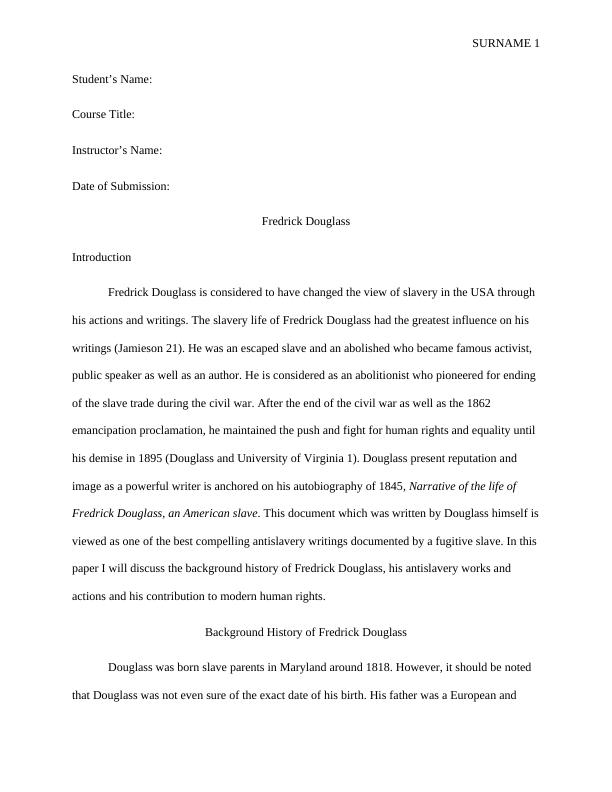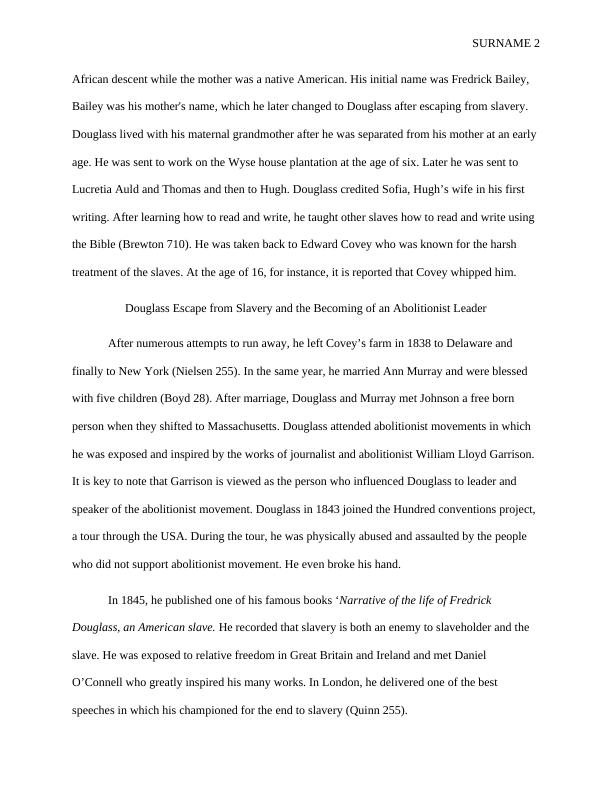The Life and Works of Frederick Douglass: An Abolitionist Leader
Added on 2023-05-30
5 Pages1329 Words115 Views
SURNAME 1
Student’s Name:
Course Title:
Instructor’s Name:
Date of Submission:
Fredrick Douglass
Introduction
Fredrick Douglass is considered to have changed the view of slavery in the USA through
his actions and writings. The slavery life of Fredrick Douglass had the greatest influence on his
writings (Jamieson 21). He was an escaped slave and an abolished who became famous activist,
public speaker as well as an author. He is considered as an abolitionist who pioneered for ending
of the slave trade during the civil war. After the end of the civil war as well as the 1862
emancipation proclamation, he maintained the push and fight for human rights and equality until
his demise in 1895 (Douglass and University of Virginia 1). Douglass present reputation and
image as a powerful writer is anchored on his autobiography of 1845, Narrative of the life of
Fredrick Douglass, an American slave. This document which was written by Douglass himself is
viewed as one of the best compelling antislavery writings documented by a fugitive slave. In this
paper I will discuss the background history of Fredrick Douglass, his antislavery works and
actions and his contribution to modern human rights.
Background History of Fredrick Douglass
Douglass was born slave parents in Maryland around 1818. However, it should be noted
that Douglass was not even sure of the exact date of his birth. His father was a European and
Student’s Name:
Course Title:
Instructor’s Name:
Date of Submission:
Fredrick Douglass
Introduction
Fredrick Douglass is considered to have changed the view of slavery in the USA through
his actions and writings. The slavery life of Fredrick Douglass had the greatest influence on his
writings (Jamieson 21). He was an escaped slave and an abolished who became famous activist,
public speaker as well as an author. He is considered as an abolitionist who pioneered for ending
of the slave trade during the civil war. After the end of the civil war as well as the 1862
emancipation proclamation, he maintained the push and fight for human rights and equality until
his demise in 1895 (Douglass and University of Virginia 1). Douglass present reputation and
image as a powerful writer is anchored on his autobiography of 1845, Narrative of the life of
Fredrick Douglass, an American slave. This document which was written by Douglass himself is
viewed as one of the best compelling antislavery writings documented by a fugitive slave. In this
paper I will discuss the background history of Fredrick Douglass, his antislavery works and
actions and his contribution to modern human rights.
Background History of Fredrick Douglass
Douglass was born slave parents in Maryland around 1818. However, it should be noted
that Douglass was not even sure of the exact date of his birth. His father was a European and

SURNAME 2
African descent while the mother was a native American. His initial name was Fredrick Bailey,
Bailey was his mother's name, which he later changed to Douglass after escaping from slavery.
Douglass lived with his maternal grandmother after he was separated from his mother at an early
age. He was sent to work on the Wyse house plantation at the age of six. Later he was sent to
Lucretia Auld and Thomas and then to Hugh. Douglass credited Sofia, Hugh’s wife in his first
writing. After learning how to read and write, he taught other slaves how to read and write using
the Bible (Brewton 710). He was taken back to Edward Covey who was known for the harsh
treatment of the slaves. At the age of 16, for instance, it is reported that Covey whipped him.
Douglass Escape from Slavery and the Becoming of an Abolitionist Leader
After numerous attempts to run away, he left Covey’s farm in 1838 to Delaware and
finally to New York (Nielsen 255). In the same year, he married Ann Murray and were blessed
with five children (Boyd 28). After marriage, Douglass and Murray met Johnson a free born
person when they shifted to Massachusetts. Douglass attended abolitionist movements in which
he was exposed and inspired by the works of journalist and abolitionist William Lloyd Garrison.
It is key to note that Garrison is viewed as the person who influenced Douglass to leader and
speaker of the abolitionist movement. Douglass in 1843 joined the Hundred conventions project,
a tour through the USA. During the tour, he was physically abused and assaulted by the people
who did not support abolitionist movement. He even broke his hand.
In 1845, he published one of his famous books ‘Narrative of the life of Fredrick
Douglass, an American slave. He recorded that slavery is both an enemy to slaveholder and the
slave. He was exposed to relative freedom in Great Britain and Ireland and met Daniel
O’Connell who greatly inspired his many works. In London, he delivered one of the best
speeches in which his championed for the end to slavery (Quinn 255).
African descent while the mother was a native American. His initial name was Fredrick Bailey,
Bailey was his mother's name, which he later changed to Douglass after escaping from slavery.
Douglass lived with his maternal grandmother after he was separated from his mother at an early
age. He was sent to work on the Wyse house plantation at the age of six. Later he was sent to
Lucretia Auld and Thomas and then to Hugh. Douglass credited Sofia, Hugh’s wife in his first
writing. After learning how to read and write, he taught other slaves how to read and write using
the Bible (Brewton 710). He was taken back to Edward Covey who was known for the harsh
treatment of the slaves. At the age of 16, for instance, it is reported that Covey whipped him.
Douglass Escape from Slavery and the Becoming of an Abolitionist Leader
After numerous attempts to run away, he left Covey’s farm in 1838 to Delaware and
finally to New York (Nielsen 255). In the same year, he married Ann Murray and were blessed
with five children (Boyd 28). After marriage, Douglass and Murray met Johnson a free born
person when they shifted to Massachusetts. Douglass attended abolitionist movements in which
he was exposed and inspired by the works of journalist and abolitionist William Lloyd Garrison.
It is key to note that Garrison is viewed as the person who influenced Douglass to leader and
speaker of the abolitionist movement. Douglass in 1843 joined the Hundred conventions project,
a tour through the USA. During the tour, he was physically abused and assaulted by the people
who did not support abolitionist movement. He even broke his hand.
In 1845, he published one of his famous books ‘Narrative of the life of Fredrick
Douglass, an American slave. He recorded that slavery is both an enemy to slaveholder and the
slave. He was exposed to relative freedom in Great Britain and Ireland and met Daniel
O’Connell who greatly inspired his many works. In London, he delivered one of the best
speeches in which his championed for the end to slavery (Quinn 255).

End of preview
Want to access all the pages? Upload your documents or become a member.
Related Documents
Life and Times of Frederick Douglass: A Narrative of Slavery and Freedomlg...
|7
|391
|272
Frederick Douglass Autobiography: Life and Timeslg...
|7
|365
|393
